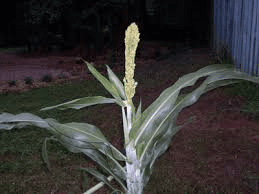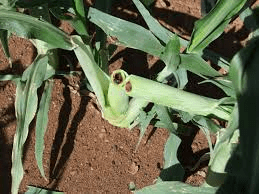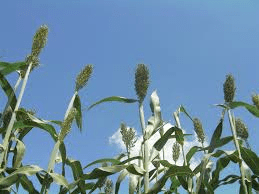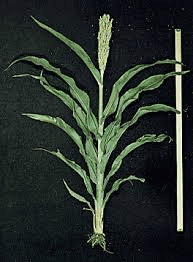Guinea corn stalks, derived from the sorghum plant (Sorghum bicolor), are an integral part of the plant’s structure and offer a multitude of uses beyond grain production. These stalks are robust and tall, often reaching heights of 2 to 4 meters. Their resilience and versatility make them valuable in agriculture, industry, and even environmental management.
The primary role of guinea corn stalks in agriculture is as a source of fodder for livestock. Once the grains are harvested, the remaining stalks, leaves, and panicles can be used as silage or hay. Silage made from sorghum stalks is a high-energy feed that is particularly useful during dry seasons when green fodder is scarce. The fibrous nature of the stalks provides essential roughage in the diets of cattle, sheep, and goats, supporting healthy digestion and overall nutrition.
In addition to their use as animal feed, guinea corn stalks are an important raw material in several industrial applications. One significant use is in the production of biofuels. The stalks, rich in cellulose, can be processed to produce ethanol, a renewable energy source.
This conversion process involves breaking down the cellulose into fermentable sugars, which are then fermented to produce ethanol. The use of sorghum stalks for biofuel production contributes to reducing reliance on fossil fuels and promotes sustainable energy practices.
Another industrial application of guinea corn stalks is in the manufacturing of paper and packaging materials. The fibers extracted from the stalks are used to produce paper pulp, which is then processed into various paper products. This use of agricultural by-products helps in reducing waste and promotes the efficient use of resources. Additionally, the biodegradable nature of sorghum-based paper products makes them an environmentally friendly alternative to traditional paper.
Guinea corn stalks also play a role in soil conservation and management. After the harvest, leaving the stalks on the field as crop residue can help prevent soil erosion. The organic matter from the decomposing stalks enhances soil fertility by adding essential nutrients back into the soil. This practice improves soil structure, increases water retention, and supports the growth of subsequent crops. The use of sorghum stalks in mulching and composting further contributes to sustainable farming practices.
In rural communities, guinea corn stalks have traditional uses as well. They are often used as construction materials for building huts, fences, and thatched roofs. The stalks’ durability and availability make them a practical choice for these purposes. Additionally, the stalks can be used as fuel for cooking and heating, providing an accessible energy source for many households.
Furthermore, research is ongoing to explore new and innovative uses for guinea corn stalks. Scientists are investigating their potential in producing biodegradable plastics, which could offer a sustainable alternative to conventional plastics. Advances in biotechnology and material science hold promise for unlocking even more applications for this versatile agricultural by-product.
Guinea corn stalks are a valuable component of the sorghum plant with a wide range of uses in agriculture, industry, and environmental management. Their role as livestock fodder, raw material for biofuels and paper, and their contribution to soil conservation highlights their importance in promoting sustainable practices. The traditional and emerging uses of sorghum stalks underscore their versatility and potential in supporting diverse economic and environmental goals.
The Economic Importance and Uses of Guinea Corn Stalks

1. Animal Feed: Guinea corn stalks are commonly used as forage for livestock, providing essential nutrients.
2. Biofuel Production: The stalks can be converted into biofuels, such as biogas or bioethanol, which are renewable energy sources.
3. Paper Manufacturing: The fibers from guinea corn stalks are used in the production of paper and cardboard.
4. Composting Material: Guinea corn stalks can be composted to create organic fertilizer, improving soil fertility.
5. Construction Material: In some regions, dried stalks are used in the construction of thatched roofs and walls for traditional houses.
6. Mulching: The stalks can be used as mulch to retain soil moisture and suppress weeds.
7. Bedding Material: Livestock bedding often includes chopped guinea corn stalks due to their absorbent properties.
8. Handicrafts: The stalks are used in making various handicrafts, such as mats, baskets, and brooms.
9. Bio-composites: Guinea corn stalks are utilized in manufacturing bio-composites, which are used in automotive and construction industries.
10. Erosion Control: The stalks can be used to create barriers that prevent soil erosion on slopes and in agricultural fields.
11. Cooking Fuel: Dried stalks are sometimes used as a cooking fuel in rural areas.
12. Packaging Material: The fibers from the stalks are used to create biodegradable packaging materials.
13. Industrial Raw Material: Guinea corn stalks are processed into cellulose, which is used in various industrial applications.
14. Biochar Production: The stalks can be pyrolyzed to produce biochar, which is used as a soil amendment to improve soil health.
15. Silage: Guinea corn stalks are ensiled to preserve them as animal feed for the dry season.
16. Textile Industry: The fibers from the stalks are used in the production of certain textiles.
17. Feedstock for Mushrooms: The stalks are used as a substrate for growing mushrooms.
18. Organic Pesticides: Extracts from guinea corn stalks are sometimes used in making organic pesticides.
Read Also: Recommended Volume of Water for Fish Farming on a Concrete Pond
The Products and By-products That Can Be Derived From Guinea Corn Stalks

1. Paper: Fibers from the stalks are used to produce paper.
2. Cardboard: Stalk fibers are also used in cardboard production.
3. Compost: Guinea corn stalks are composted to produce organic fertilizer.
4. Bioethanol: Stalks are fermented to produce bioethanol, a type of biofuel.
5. Biogas: The stalks are anaerobically digested to produce biogas.
6. Mulch: Shredded stalks are used as mulch in agriculture.
7. Bedding: Chopped stalks are used as livestock bedding.
8. Thatch: Dried stalks are used in thatching roofs.
9. Handicrafts: Stalks are woven into mats, baskets, and brooms.
10. Bio-composites: Fibers are used in manufacturing bio-composites for various industries.
11. Cooking Fuel: Dried stalks are used as a fuel source for cooking.
12. Packaging: Stalk fibers are used to create biodegradable packaging.
13. Cellulose: Stalks are processed into cellulose for industrial use.
14. Biochar: Stalks are pyrolyzed to produce biochar.
15. Silage: Stalks are ensiled to preserve them for animal feed.
16. Textiles: Stalk fibers are used in textile production.
17. Mushroom Substrate: Stalks are used as a substrate for mushroom cultivation.
Read Also: Concrete Pond Management: Steps to take before introducing the Fish in the Water
Frequently Asked Questions (FAQ’s) About Guinea Corn Stalks

1. What are guinea corn stalks?
Guinea corn stalks are the fibrous stems of the guinea corn plant, also known as sorghum.
2. How are guinea corn stalks used in agriculture?
They are used as animal feed, mulch, compost, and silage.
3. Can guinea corn stalks be used for biofuel?
Yes, they can be converted into bioethanol and biogas.
4. What products can be made from guinea corn stalks?
Products include paper, cardboard, bio-composites, and biochar.
5. Are guinea corn stalks used in construction?
Yes, they are used in thatching roofs and walls for traditional houses.
6. How do guinea corn stalks contribute to soil health?
They are used as compost and mulch, which improve soil fertility and moisture retention.
7. Can guinea corn stalks be used in the textile industry?
Yes, the fibers from the stalks are used in textile production.
8. What is the role of guinea corn stalks in erosion control?
They are used to create barriers that prevent soil erosion.
9. How are guinea corn stalks used in handicrafts?
They are woven into mats, baskets, and brooms.
10. Are guinea corn stalks biodegradable?
Yes, they are used to produce biodegradable packaging materials.
Read Also: Adaptive Means of Animals Coping with the Environment

